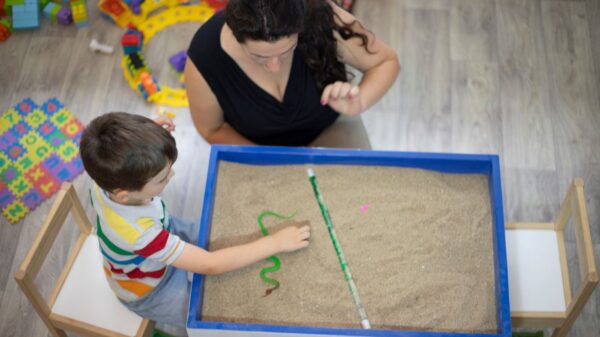Pathological Demand Avoidance (PDA) is a unique profile often seen in children with autism spectrum disorder (ASD). Kids with PDA face specific challenges, often feeling overwhelmed by everyday demands and expectations.
This isn’t about being defiant—it comes from anxiety and a strong need to feel in control. PDA can show up as sudden mood changes, avoiding simple requests, or withdrawing socially, especially with extreme demand avoidance.
At The Clubhouse, we understand how complex PDA can be, for both parents and your kids. We also understand the importance of individualized strategies for ABA or Applied Behavior Analysis therapy, specifically tailored to meet the needs of children with PDA.
Our ABA therapists work closely with children and their families to create kind, personalized strategies that help kids thrive.
Learn More About How ABA Therapy Can Help Your Kid Succeed!
Collaborative Approach
Instead of traditional ABA methods that focus on demands and consequences, it’s important to take a more collaborative approach with children who have PDA. Studies show that these kids are very sensitive to demands, which can cause anxiety and lead to avoidance. Building trust and giving them a sense of control are key to creating effective and supportive interventions.
Involve the Child in Decision-Making Processes
Children are more likely to cooperate when they feel heard and their choices are valued. This is especially important for children with Pathological Demand Avoidance (PDA), often linked to autism. These children may avoid everyday demands due to high anxiety and a strong need for control.
Creating an environment where they can take part in decisions about their activities and routines can make a big difference. For example, instead of giving them a task, you could offer two or three options and let them choose. Or you could involve them in planning their day such as after school, like deciding the order of activities. These small choices help them feel more in control.
When children with PDA feel respected and see that their opinions matter, their anxiety often decreases. This makes it easier for them to engage and reduce resistance or shutdowns. By making simple adjustments and showing understanding, you can create a more supportive and positive space for these children to thrive.
Offer Choices to Give a Sense of Control
Giving kids choices helps them feel in control and respected, rather than feeling forced into something. For example, if you ask a child, “Would you like to start with this activity or that one?” they get to decide what they do next.
This small act of letting them choose can make a big difference—it helps them feel more confident and comfortable, which makes them more likely to participate positively. This kind of approach not only reduces the chances of them avoiding tasks but also encourages them to engage better in activities, like therapy sessions. It’s all about working with your child, not against them and creating an environment where they feel safe and understood.
Use Indirect Language to Reduce Perceived Demands
Using softer, more indirect language instead of direct commands can be a helpful way to communicate in a kinder, more effective manner. For example, instead of saying “Sit down now,” you could say something like, “I wonder if we should get comfy over here.”
This approach works because it feels less like an order and more like a suggestion, which can reduce any feelings of pressure or resistance. Making a request sound gentler can help your kid feel more comfortable and open to cooperating.
Flexible and Individualized Programming

Tailoring the ABA program to the unique needs of each child with PDA is crucial. Every child experiences Pathological Demand Avoidance differently, which means there is no “one size fits all” approach.
By truly understanding the individual challenges and preferences of the child, our board-certified behavior analysts (BCBAs) can create a personalized program that meets the child’s specific needs. Studies show that a personalized approach is more effective and leads to better outcomes.
This can involve creating flexible spaces, adjusting expectations, and modifying strategies to better align with each child’s needs. The key here is empathy, flexibility, meeting the child where they are, and adapting to what works best for them.
Learn More About How ABA Therapy Can Help Your Kid Succeed!
Create Flexible Learning Environments That Allow for Breaks and Alternative Spaces
Children with PDA often struggle in environments that feel too strict or demanding. They can easily feel overwhelmed when faced with rigid schedules or tasks that go on for too long. Research shows that giving kids with ASD more flexibility in their learning environment can make a big difference in their comfort and engagement.
For example, if a child feels upset or stressed during an activity, having a quiet corner or a calming, sensory-friendly space they can go to allows them to take a break and calm down. This helps the child feel less pressured and more in control of their situation.
When children feel like they have some choice and freedom, they are less likely to feel trapped or anxious. This kind of adaptable approach creates a more positive and supportive learning experience, helping the child feel safe, understood, and ready to learn at their own pace.
Develop Individualized Support Programs Focusing on Building Flexibility in Behavior
Individualized programs are a helpful way for therapists to gently teach kids how to be more flexible. For kids with PDA, staying rigid or stuck in certain behaviors can often be their way of coping with anxiety. It feels safe and predictable for them.
Therapists work carefully to introduce small changes, offering choices and support along the way. This helps the child feel like they have some control while slowly learning that change can be okay.
Taking small steps, offering constant encouragement, and praising progress can help kids with ASD feel more comfortable with unexpected situations. Over time, this approach helps kids see that change isn’t something scary, and it builds up their ability to handle new or uncertain experiences.
It’s all about patience, understanding, and showing them that they’re supported every step of the way.
Adapt Goals and Expectations Based on the Child’s Current State and Anxiety Levels
A child’s ability to learn and engage depends on their emotional state. When they feel anxious or overwhelmed, it’s important to focus on calming activities and ease up on expectations.
On the other hand, when they’re calm and at ease, they’re more open to challenges and learning new skills. Adapting to a child’s emotional needs shows understanding, builds trust, and creates a supportive environment for meaningful, lasting progress. Prioritizing emotional health helps children thrive.
Positive Behavior Support
ABA therapy for kids with PDA also emphasizes positive behavior support. This means understanding why a child behaves a certain way and finding ways to guide them toward more helpful responses. Instead of punishing unwanted behaviors, therapists focus on encouraging positive ones through reinforcement.
They also work on teaching children how to express their needs clearly, which can reduce frustration and challenging behaviors. This approach not only helps with day-to-day challenges but also builds important social and communication skills.
Include Sensory Diet Activities as Part of the Therapy Sessions
A sensory diet isn’t about food—it’s about giving children the sensory input they need to feel calm and in control. For children with PDA, sensory activities can help them feel more grounded and better able to handle challenges.
These activities could include using weighted blankets, playing with sensory bins filled with sand or rice, or doing physical exercises like trampoline jumping. Research shows that the right sensory input can have a calming effect on both the brain and body. By including these activities in therapy, children learn ways to manage their sensory needs, which can reduce feelings of overwhelm. It’s important to choose activities that the child enjoys and feels comfortable with, as their happiness is key to making these strategies work.
Teach Calming Techniques to Help Manage Anxiety and Stress

Children with PDA often feel intense anxiety, which can lead to difficult behaviors. Teaching them calming techniques, like yoga, deep breathing, muscle relaxation, or mindfulness activities, can help them manage this anxiety.
Research shows mindfulness can lower stress, even in young kids. Simple tools like visual aids, guided meditations, or “breathing buddies”, which is using a stuffed animal to practice belly breathing, can make a big difference.
It’s important to be empathetic, acknowledge their feelings, and guide them gently. Over time, these calming strategies can help them feel more in control and become a valuable part of their emotional toolkit.
Modify The Environment To Reduce Sensory Overload
Making changes to a child’s environment can have a big impact on those with PDA. Sensory overload often leads to anxiety or challenging behaviors, so creating a calm, comforting space can help. This might mean using soft lighting, reducing noise, and setting up a quiet area with cozy items like cushions or fidget toys.
The American Journal of Occupational Therapy highlights that adapting environments to a child’s sensory needs can improve focus and lower stress. Caregivers can also make simple changes at home, like clearing clutter or using calming colors. These adjustments show children that their needs are understood and valued, helping them feel more secure and emotionally balanced.
Alternative Communication Methods
Children with PDA may find it challenging to express themselves and communicate. Therapists can try different approaches to find what works best for each child.
Using visual aids like picture cards or schedules can help kids understand and share their needs. Other options, like sign language or assistive devices, can give them a way to communicate without words.
These tools can ease frustration and help children feel more understood and independent.
Introduce Visual Supports and Schedules
For children with PDA, visual supports and schedules can be incredibly helpful in managing daily routines. These tools break tasks into simple, clear steps using pictures, symbols, or written words, making things easier to understand. Visual aids like daily schedules or task charts can reduce uncertainty and ease anxiety by showing what to expect.
Research shows that children with autism, including PDA, often do better with structured visual supports. These tools not only improve understanding but also help kids feel more engaged and confident. Simple solutions like picture cards or apps for creating schedules can make a big difference, helping children feel more in control and less dependent on caregivers for constant guidance.
Utilize AAC Devices or Techniques as Needed
Augmentative and Alternative Communication (AAC) tools can be life-changing for children who face hurdles with communication. These tools range from simple picture systems to advanced tablets with speech-generating apps.
Research shows that AAC gives kids with autism a voice when spoken language feels challenging or overwhelming. For kids with PDA, AAC can help them express their needs, make choices, and share feelings without the pressure of speaking.
Contrary to myths, AAC doesn’t hold back language development—it supports it. Many children using AAC find it easier to communicate and often see their skills grow over time.
By reducing frustration and providing a way to connect, AAC allows children to interact more meaningfully with others. When these tools are tailored to a child’s unique needs, they can break down barriers and create more inclusive, supportive environments.
Teach Functional Communication Skills to Express Needs and Feelings
Helping kids with PDA develop communication skills is an important step in helping them express their needs and feelings more easily. Functional communication focuses on practical, everyday ways to communicate, like asking for help, showing preferences, or sharing when they’re upset.
Research shows that kids with autism benefit from approaches like Functional Communication Training, which teaches positive ways to replace challenging behaviors. For children with PDA, this might mean learning simple words, hand signals, or using a communication board to share things like feeling hungry, uncomfortable, or needing space.
The goal is to make communication clearer and help kids feel understood, creating stronger connections with caregivers and peers. By teaching these skills, we empower them to advocate for themselves and feel more in control in an often overwhelming world.
Modified Assessment Techniques

Traditional methods like standardized tests and structured interviews often miss the unique traits and challenges of PDA. Children with PDA may do well on these tests because of their strong verbal skills and high intelligence, which can make it harder to recognize their struggles.
This shows why it’s so important to use tailored assessment approaches that truly understand and reflect their needs.
Use Practical Functional Assessments (PFAs) to Gather Information About Triggering Situations
Practical Functional Assessments (PFAs) are a helpful tool for understanding children with PDA traits. Unlike traditional methods, PFAs focus on identifying PDA and the specific situations or triggers that make a child feel anxious or out of control.
By observing and understanding behaviors flexibly and thoughtfully, caregivers and professionals can figure out what causes the child distress or avoidance. For example, a 2016 study shows that children with PDA often see even small demands as threats.
By approaching this with care and empathy, we can uncover these patterns and reduce triggers, helping the child feel safer and more comfortable. This deeper understanding allows us to create a support plan that truly works for them.
Create a Low-Demand Environment During Initial Sessions to Build Rapport
Building trust with a child who has PDA starts with creating a low-pressure environment. For these children, even small requests can feel overwhelming and may lead to withdrawal or outbursts.
Reducing demands helps them feel more in control and avoids triggering their fight-or-flight response. Early sessions with a caregiver or therapist should focus on creating a calm, stress-free space where the child feels safe and unpressured.
The goal is to connect with the child on their terms, showing patience and respect for their boundaries. This gentle approach helps build trust and sets the stage for a more supportive and collaborative relationship.
Observe the Child in Naturalistic Settings to Understand Their Behavior Patterns
To truly understand a child with PDA, it’s important to observe them in places where they feel safe and comfortable, like at home or during playtime. These natural settings show how the child responds to everyday demands and interacts with others.
More structured environments, like clinics, might not show the full picture because children can hide their struggles and seem more compliant. By watching them in real-life situations, caregivers and professionals can pick up on subtle signs, like avoidance behaviors or emotional triggers, that might otherwise be missed. This insight helps create personalized strategies to better support their unique needs and offer meaningful help.
Final Thoughts
Understanding and supporting children with PDA requires patience, empathy, and a deeper look into their daily lives. By recognizing their challenges and adapting approaches to meet their unique needs, we can help them feel understood, secure, and empowered to thrive.
At The Clubhouse, we specialize in providing professional ABA therapy services designed to help children with PDA and their families succeed. Our dedicated team works closely with both the child and their support network, ensuring a holistic approach to care.
Together, we aim to foster growth, resilience, and confidence—not just for the child, but for the wider community surrounding them.

